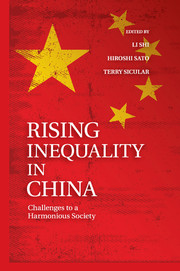Book contents
- Frontmatter
- Contents
- List of Tables
- List of Figures
- Contributors
- Preface
- Abbreviations
- Glossary
- 1 Rising Inequality in China
- 2 Overview
- 3 Housing Ownership, Incomes, and Inequality in China, 2002–2007
- 4 Educational Inequality in China
- 5 Inequality and Poverty in Rural China
- 6 The Evolution of the Migrant Labor Market in China, 2002–2007
- 7 A New Episode of Increased Urban Income Inequality in China
- 8 Unemployment and the Rising Number of Nonworkers in Urban China
- 9 Do Employees in the Public Sector Still Enjoy Earnings Advantages?
- 10 Redistributive Impacts of the Personal Income Tax in Urban China
- 11 Changes in the Gender-Wage Gap in Urban China, 1995–2007
- 12 Intertemporal Changes in Ethnic Urban Earnings Disparities in China
- Appendix I The 2007 Household Surveys
- Appendix II The 2002 and 2007 CHIP Surveys
- Index
- References
8 - Unemployment and the Rising Number of Nonworkers in Urban China
Causes and Distributional Consequences
Published online by Cambridge University Press: 05 July 2013
- Frontmatter
- Contents
- List of Tables
- List of Figures
- Contributors
- Preface
- Abbreviations
- Glossary
- 1 Rising Inequality in China
- 2 Overview
- 3 Housing Ownership, Incomes, and Inequality in China, 2002–2007
- 4 Educational Inequality in China
- 5 Inequality and Poverty in Rural China
- 6 The Evolution of the Migrant Labor Market in China, 2002–2007
- 7 A New Episode of Increased Urban Income Inequality in China
- 8 Unemployment and the Rising Number of Nonworkers in Urban China
- 9 Do Employees in the Public Sector Still Enjoy Earnings Advantages?
- 10 Redistributive Impacts of the Personal Income Tax in Urban China
- 11 Changes in the Gender-Wage Gap in Urban China, 1995–2007
- 12 Intertemporal Changes in Ethnic Urban Earnings Disparities in China
- Appendix I The 2007 Household Surveys
- Appendix II The 2002 and 2007 CHIP Surveys
- Index
- References
Summary
Introduction
Before the economic transition, almost all urban women between the ages of sixteen and fifty (for manual workers) or fifty-five (for professional workers) and urban men between the ages of sixteen and sixty worked for an income. This situation changed when China modernized and moved toward a market economy. In this chapter we show that whereas only 6 percent of those of working age who had an urban residence permit were nonworkers in 1988, the proportion increased to 15 percent in 1995, to 29 percent in 2002, and to as much as 36percent in 2007. Such a rapid change in the expenditure burden is difficult to cope with in most economies. China, however, has experienced very rapid economic growth, as well as favorable demographic changes because many young persons were entering the labor force and few children were being born. In addition, an increasing proportion of paid work in urban China was performed by rural migrants, who generally work long hours and are paid less than urban residents.
The rise of nonworkers in urban China is the result of various processes that to some degree have affected persons differently, both over time and in terms of age. One process that is shared with many rich countries is the rapid expansion of education since the late 1990s, leading to more young adults remaining students and not working for an income. Furthermore, during the planning era, the transition from being a student to one's first job (which often became life-long) typically did not involve periods of enforced nonwork. In contrast, more recent changes mean that school-leavers in contemporary China may experience periods of unemployment before gaining a foothold in working life, as is also the case in many rich countries. In this respect, therefore, the Hu Jintao–Wen Jiabao leadership period represents a continuation of circumstances that appeared at the end of the preceding period.
- Type
- Chapter
- Information
- Rising Inequality in ChinaChallenges to a Harmonious Society, pp. 289 - 331Publisher: Cambridge University PressPrint publication year: 2013
References
- 6
- Cited by



